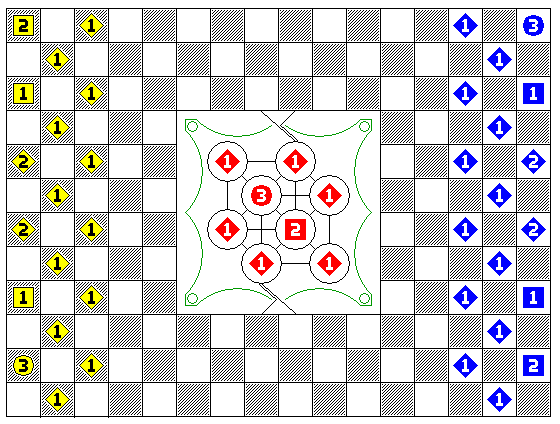
This game, inspired by the siege of Paris during the War of 1871, is mentioned in numerous books about old board games; thus, I presume it was popular, and thus is of interest and importance.

The diagram above shows the initial array, at least as described by some of the accounts of the rules. Note that the initial array is not symmetrical because of the placement of the Generals and Colonels for the two beseiging sides.
From top to bottom, on the left side of the diagram, the yellow pieces on the back row are one Colonel, one Captain, two Lieutenants, one Captain, and one General. The pieces in the two rows forward are all Men.
Some accounts of the rules interchange the locations of the Blue Colonel and General to make the layout symmetrical.
The position shown for the Red pieces is arbitrary, as the Red player may arrange his pieces in any fashion of his choosing.
According to one account, the Yellow pieces represent the Prussian forces, and the Blue pieces represent the German forces. I would have thought it was the other way around, since Prussian Blue is well known.
The rules describe the moves of these pieces as follows:
However, there is an important issue with these moves, at least in some accounts of these rules. According to those accounts, yellow pieces can only move to black squares, and blue pieces can only move to white squares.
As well, according to those accounts, when a red piece leaves the garrison of Paris, it cannot change the color of square that it is on by any move, although it can exit the garrison to either color of square. As well, only six pieces of the Red team may ever be outside the Garrison at any one time, and no more than three of them may be on either color of square.
To reconcile these rules with the descriptions of the moves of the men, I think the only thing that can be done is to presume that an orthogonal move of one step is actually a move of two squares, so that in this game it is the orthogonal steps, rather than the diagonal steps, that are longer.
Within the Garrison, all pieces move from one circular space to the next one step along the lines that connect the spaces.
They can also move along the lines that link the Garrison to four squares on the main board, and from those squares, pieces may also enter the Garrison by moving along these lines.
Only the Red pieces may capture; capture is by displacement, as in Chess; and they may only capture pieces of either besieging player when outside the Garrison and on the regular board.
The pieces of the two besieging teams may only move forwards; to the right on the diagram for the Yellow pieces, and to the left on the diagram for the Blue pieces. Some accounts of the rules only place this restriction on the Men. When that is not the case, I believe sideways movement is still also allowed.
The besieging players can win in one of two ways: by placing at least one officer and three Men in the Garrison, or by obstructing the Red pieces so that they cannot move on the Red player's turn.
The Garrison player can win by capturing at least six officers and twenty-four Men from the two besieging players combined.
The order of turns is Yellow, Red, Blue, Red, continuously repeating, so the Red player has twice as many turns as either of the besieging players.
Although the besieging player cannot capture, if a besieging piece is situated so that, if it could capture, it would recapture the capturing piece if another man was captured, that other man may not be captured. So although the besieging players cannot capture the Red pieces, they can defend their own pieces.
Some accounts of the rules make capture optional, as in Chess, and others make it compulsory as in Checkers.
Here is a table, giving some of the versions of the rules for this game I've encountered, as a further help to sort out the confusion:
| Rule | Original Rule Set on Board Game Geek Site | The Boardgame Book by R. C. Bell | Play the Game by Brian Love | The Book of Games by Jack Botermans |
| Are Generals and Colonels confined to only one color of square? | No | No | Yes | No |
| Is capture compulsory? | No | Yes* | No | Yes |
| Are besieging Generals, Colonels, and Lieutenants allowed to move backwards? | No | No | No | No, except for Lieutenants, which may move backwards. |
| Is the General always on the right, and the Colonel always on the left? | Yes | Yes | Yes | Yes |
In the version of the rules in R. C. Bell's book, failing to capture when it is possible to do so, rather than being a strictly illegal move, is only not allowed if the opponent explicitly requests that the capture be made; of course, this request can be made after another move is attempted.
According to the rules in Jack Botemans' book, not only can the Lieutenant move backwards, but so can the Man (called a Soldier in that book). This, of course, is the opposite of the pattern in Chess, where the Pawns are the only pieces that cannot move backwards.